|
Gardening Scotland 2007 an extended visit --
-- only 3 days to see it all
by Sandy Leven
Members of the public still swarmed around SRGC President Ian Christie's stand

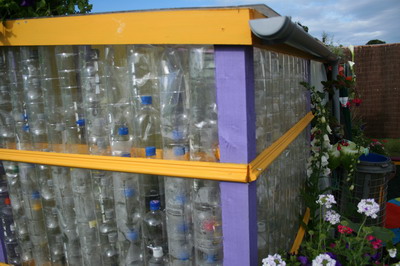 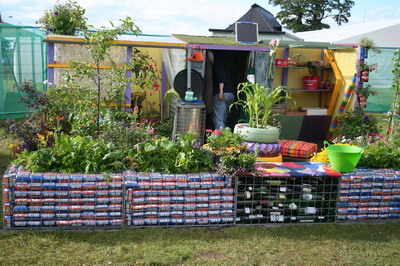
The only piece in the Herald on the Saturday of the show was a picture and a headline about a rubbish garden winning. The garden featured a greenhouse made from plastic lemonade bottles and a wall of IrnBru cans in wire containers. The BBC hardly mentioned it - there were no traffic jams and the weather stayed fine. They seem to prefer bad news to good! The week before, The Chelsea Flower Show was on BBC2 for hours. I know I watched a lot of it, even the 'red button' special selections. You would think that either he BBC or STV could devote some time to our biggest garden show.
Thank goodness for the Beechgrove Garden and Beechgrove Potting Shed. The Beechgrove Theatre at the show is deservedly popular. Jim McColl, Carol Baxter and Leslie Watson must have their own fan clubs, they are so popular. This time Jim Jermyn and Bill Anderson were answering the questions.
The Beechgrove did what they could in their normal programme time slots but here they are preaching to the converted. The audience for these programmes is probably mainly gardeners. It would be much better to reach out to others who are unaware of Gardening Scotland. [As write 'T in the Park' is swamping the media, whether you are interested or not. As well as their expected coverage they also made the news because of traffic jams and wet fields.] Hopefully next year we will see Gardening Scotland on TV in build up programmes and live from the show for 3 days.
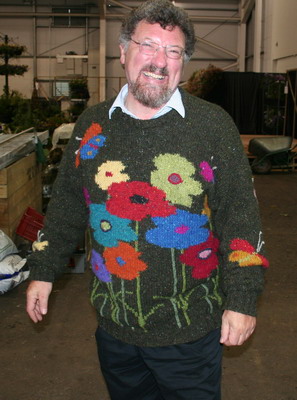
Another celebrity, David Mitchell of the RBGE, was auctioning a jersey like this for charity. It is fully 'green compliant'- organic wool, natural dies and best of all Scottish made. I hope he raised a lot of money.
A bit like the former champions at Wimbledon, the SRGC team can wander round the show appreciating everything that they see and understanding just how hard you have to work to gain a gold medal. It is great to build a garden a even better when people come along to admire it but it takes dedication and determination to be successful. Well done everyone who contributed to this year's displays.
Well done us - we got a card from the organisers for our excellent contribution.
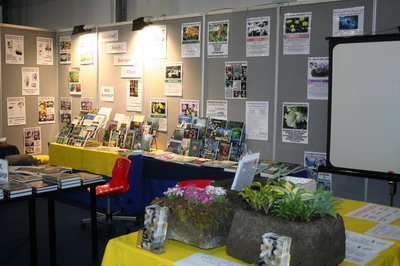
The SRGC exhibit was popular. Since we did not stage a floral exhibit we decided that an educational exhibit would be appropriate. We sold many books and the number of titles was greatly expanded thanks to an agreement with Timber Press. David and Carole Shaw worked hard during the 3 days. There were bargains to be had and I snapped up a couple myself. With gardening books, if you don't buy a title when you see it, it may be out of print by your birthday or Christmas, so buy it right away. New titles are constantly coming out and the current stock has to be sold. Members can buy by mail order.
'Hypertufa Troughs'
We had a static demonstration on making 'Hypertufa Troughs'. A fish box; a fish box wrapped in chicken mesh; a new 'Hypertufa Troughs' and a 10 years old 'Hypertufa Troughs'. The latter two were planted with Hostas and Rhodohypoxis. The PowerPoint presentation 'Hypertufa Troughs' runs for about 6 minutes and created a lot of interest. Leaflets about making 'Hypertufa Troughs' were given a way to interested gardeners.
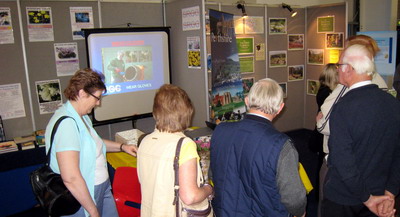
SRGC Presentation Visitors view the SRGC Presentation, although the lady on the left seems to be a bit distracted, she is actually looking at a real trough and poking it with her finger.
SRGC member and artist Eileen Goodall poses beside a giant Meconopsis. Many members have been able to admire Eileen's paintings at the SRGC Edinburgh show. The spell checker does not like Meconopsis: it suggested 'decomposes' or 'recomposes'.
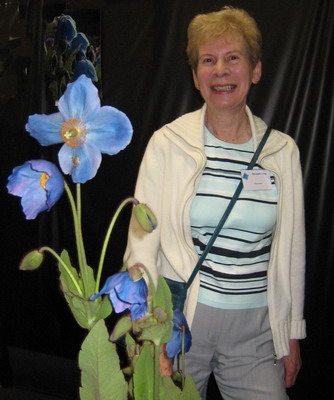
Eileen Goodall beside 'Meconopsis gigantica' !
Hampshire Carniverous Plants, from near Southampton, staged a good selection of pitcher plants and Saracenias. They were rewarded with a gold medal.
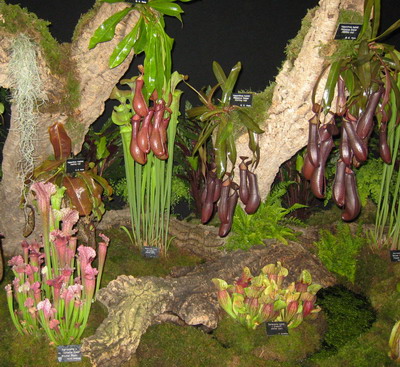
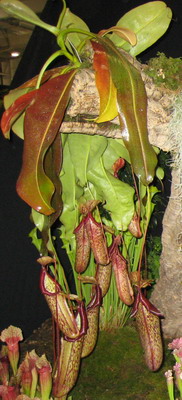
On TV we were shown a pitcher plant which could consume a rat! I did not see that one at this show. The pitcher plants are formidable things, They use smell to attract insects into the pitcher which has waster in the bottom. If he insect lands in the water a wetting agent renders its wings useless. When it starts to climb out using wee suckers on its feet, goo on the inside of the pitcher gums up the suckers. It then tries its luck with the tiny claws on its feet only to find that the pitcher is so slippy it can't get a grip. It falls back into the water where it drowns and is digested by the pitcher. Apparently some pitchers eat mice and birds and one does eat rats!
I love Heucheras.
Every year Cairnsmore Nursery have new varieties appear to tempt me. Heucheras do well in Dunblane and they are great plants for creating a focal point in the garden. 10 years ago deep purple leaves were the 'new thing'. Now bright green and orange / coffee colours are grabbing the attention. Most of the new varieties originate in America, which is only fair as Heucheras are native to North America. Like Hostas, although they are planted for foliage effect you get flowers as well. Heucheras are members of the Saxifragaceae family
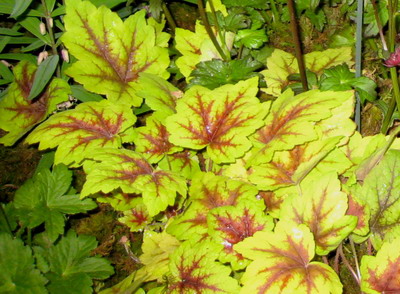
Heucheras 'Spotlight', combines bright green with a purple centre.
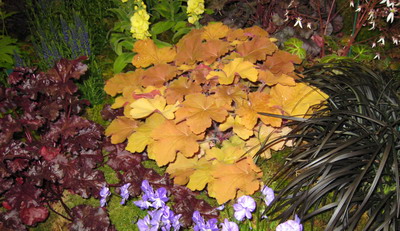
Heucheras 'Liquorice'
[I know that in English it is 'Liquorice'! ] on the left and H.'Caramel' in the centre. The flash makes Licorice redder than it appears to the eye.
Further round was a Heucheras which I fancy is an acquired taste, H. 'Snowfire'. It is different and just the thing if you want variegated leaves. I seem to remember that in the 1950's Snowfire ointment was something like Germolene. Now sold as tablets they are described thus -'Snowfire healing tablets are solid emollient ointment for chapped hands and chilblains.'
Just what a busy gardener might need.
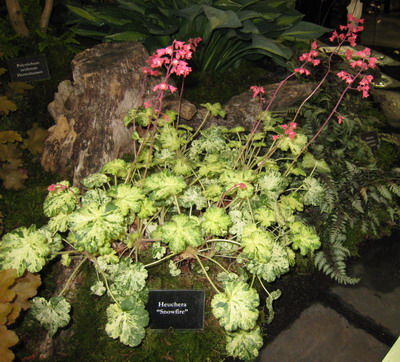
Heucheras 'Snowfire'
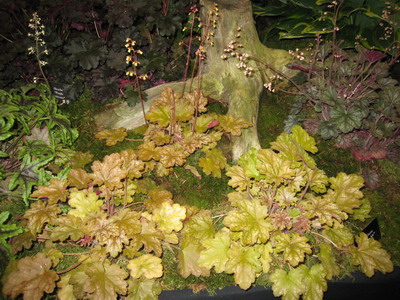
Heuchera 'Ginger Ale' - more to my taste.
Sited appropriately beside some Heucheras was a fine patch of Saxifraga stolonifera. I grew this when I was a child, before I knew about rock gardens and vine weevils. We kept it in our conservatory. I still think of it as a house plant!
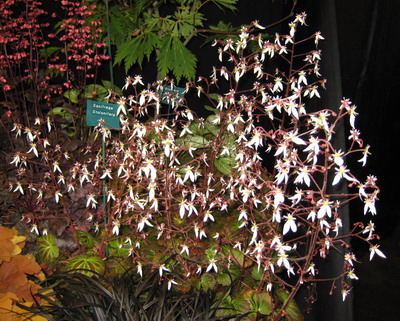
Saxifraga stolonifera, with a caramel coloured Heuchera at the front right
Glendoik Nurseries are famous for their wonderful Rhododendrons. They showed a few young rhodies interspersed with some Asiatic Primulas and Hostas. I found their white labels were most intrusive and the young plants did not really convey the grandeur of these my favourite shrubs. Still there was plenty colour and I am sure everyone who saw the new red leaved Rh 'Evered' would be keen to snap one up.
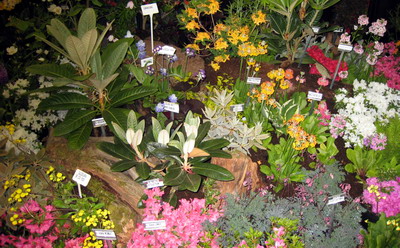
Glendoik Plants display
I have always liked Pelargoniums and here there were some really sumptuous ones to choose from.
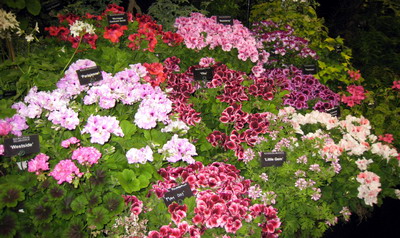
Lilies from Two Plants
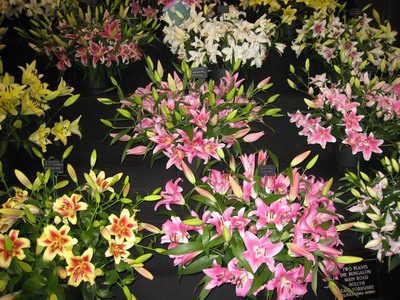 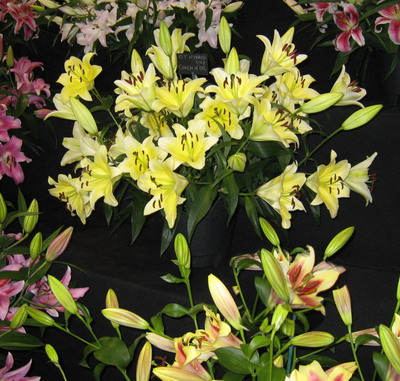
Two drinks and a theatre. Bring on the dancing girls!
Astrantias make fine plants for the herbaceous border because they keep their flower shape for a long time. In the wild the flowers are mainly greeny cream in colour but now there are several clones with dark red flowers like this Astrantia 'Bloody Mary' - do you sing about it or drink its health? I bought one.

Astrantia 'Bloody Mary'
Moulin Rouge is paler but dwarfed, a bit like Toulouse Lautrec after he spent too much time in the Moulin Rouge! In between the two in maroon-ness and size is Astrantia 'Claret'. Two drinks and a theatre. Bring on the dancing girls! Who could imagine all this excitement from an Astrantia?
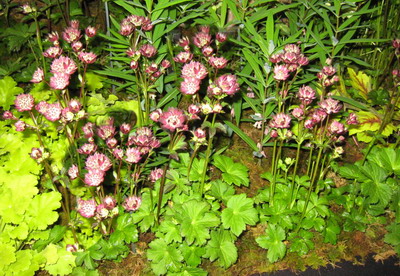
Astrantia 'Moulin Rouge'
Scattered amongst other displays were some plants which I liked.
Ingwersens' Nursery is almost on the English Channel at West Grinstead. Each year their display contains a lot of Rhodohypoxis.
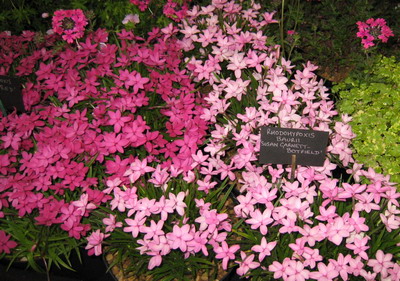
Rhodohypoxis Susan Garnett-Botfield is the pale pink one at the front. Rh. Tetra Red is on the left.
Rhodohypoxis Susan Garnett-Botfield is a new selection to me and when you find out who the lady was you will see how little I know about Rhodohypoxis. I wondered who she was, so I Googled the name and found Maggi Young's explanation to Luit Van Delft about Rhodohypoxis 'Great Scott'. Mrs Garnett-Botfield was the mother of Ruth McConnell a famous member of the SRGC in the 1960's, who popularised Rhodohypoxis. Between them Ruth McConnell and her mother raised and named just about all the named forms of Rhodohypoxis baurii. There is short article by Ruth in the SRGC Journal.
There was a South African feel to Ingwersens' stand as they had a big patch of Zalusianskya ovata in the centre.

Zalusianskya ovate behind Rhodohypoxis baurii confecta
Gretna Green Cottage Plants would be fine place to visit before you visited the blacksmith, just in case you needed to consider your future. They had a nice display with lots of variety.
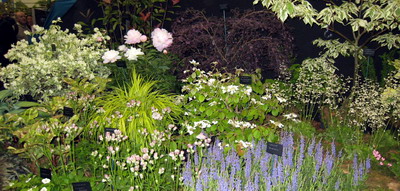
Gretna Green plants
Billy Caruthers of Binny plants always has an excellent display. This year he worked with a garden designer who built pools and planters and a fine waterfall using iron which rusted on the surface but would not rust through. A bit like 'The Angel of the North' in Gateshead. The tall conifers gave the garden an Italianate feel. A sinister presence was created by his use of black pebbles as ground cover.
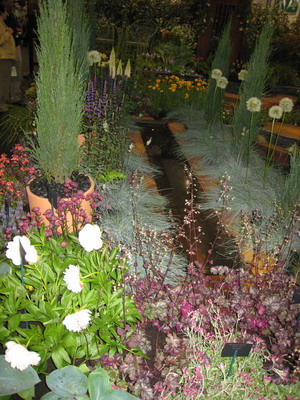
Binny Plants
As usual Billy had some magnificent Paeonias. This one is called 'Clare de Lune'. I learned to sing that at school and I still haven't found 'mon ami, Pierot'. According to The Seekers he ran off to join Columbine in the Circus.
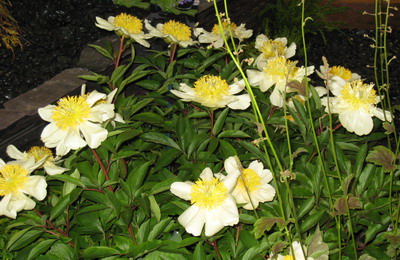
I had never heard of Mathiasella beupleurodes 'Green Dream' but it was fabulous; just like a tree lupine crossed with a hellebores foetidus.
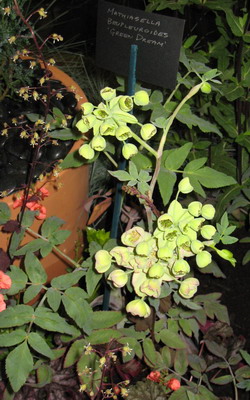
Mathiasella beupleurodes 'Green Dream'
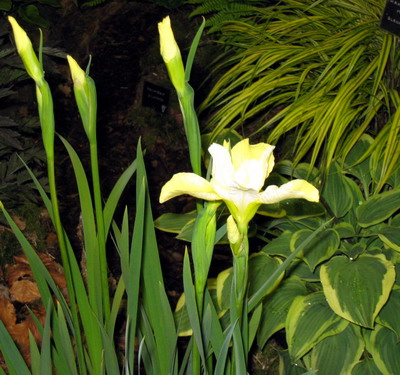
Iris 'Butter and Sugar' I bought one of these. A creamy yellow sibirica.
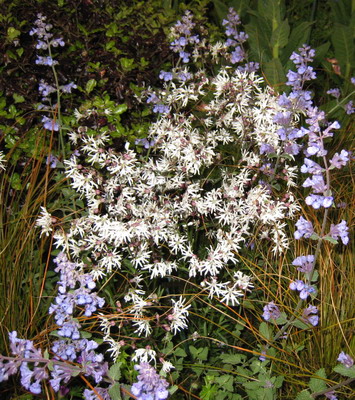
Lychnis flos cuculi 'White Robin' , a white form of the native Ragged Robin and Verbascum 'Pink Petticoats' towering above. [In the world of rock gardening we do not mention underwear, that is one reason why rock gardening is at the pinnacle of gardening.]
The City of Munich took a large site in the main hall. There was a lot of grass and paving with cyrved flower beds, planted in a 'mainland European' way, with bright pink pelargoniums, pastel petunias, daisies and other annuals with red cordalines and red 'maize' for height and contrast. The site was reminiscent of a German park. I wondered if Munich was celebrating its association with Jim Jermyn, the show manager but was told that it was actually the 700th anniversary of Munich city
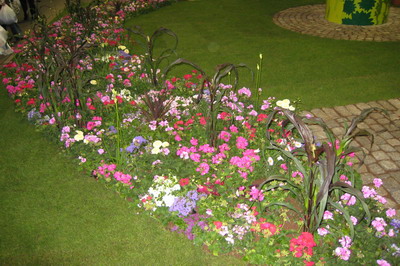 
City of Munich exhibit
Outside the main hall visitors took advantage of the 3 days of fine weather to shop at the huge range of stalls selling plants, trolleys, gardening sundries, clothes, huts, greenhouses and spa-baths; not to mention the huge craft fair. There is certainly something for everyone at Gardening Scotland.
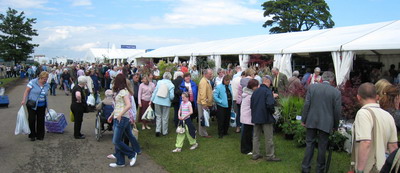
Outside Gardens were scarce. Carol McCulloch from Doune whose husband is a fellow Member of Stirling Rotary Club built a big garden called Snakes and Ladders. I would not like to have to cut the grass. One corner used crushed blue glass as a mulch.
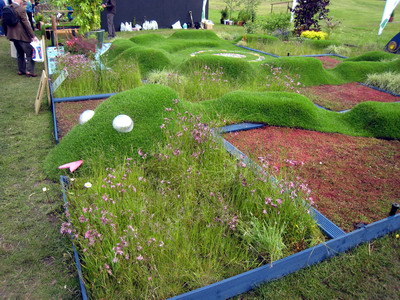 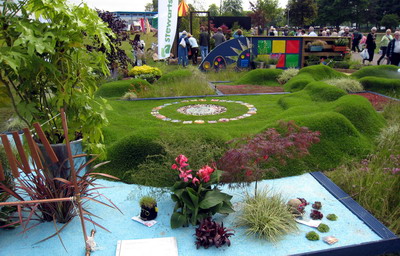
Snakes and Ladders garden
Nearby we had a plea for retaining weeds. This very tidy garden with a fine steps and patio combined these geometric elements with good planting. The Plea for weeds was engraved on wood on the backing board. A bottle of Famous Grouse sat on the bench, presumably to be consumed while pondering the poem:-
What would the world be, once bereft
Of wet and wildness? Let them be left,
O let them be left, wildness and wet.
Long live the weeds and the wilderness yet.
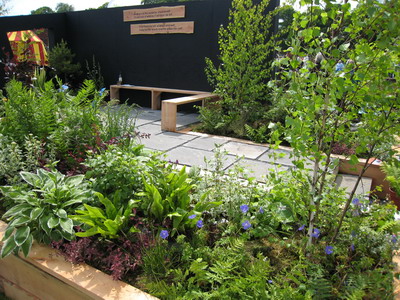
John Amand of Jacques Amand Nursery always delights us with fabulous cypripediums and Arisaemas. I think He has single handedly convinced the gardening public that they must grow at least one Arisaema. Quality plants beautifully displayed!
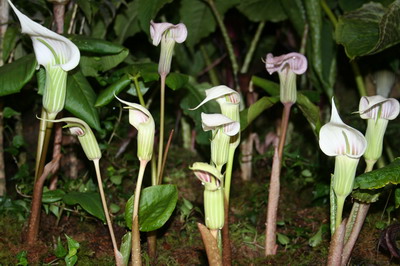
Arisaema candidissimum
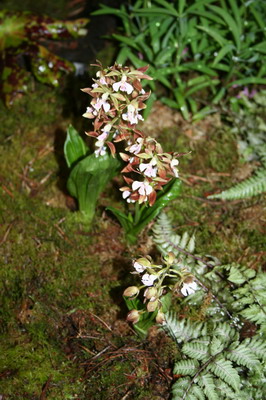
Calanthe bicolour
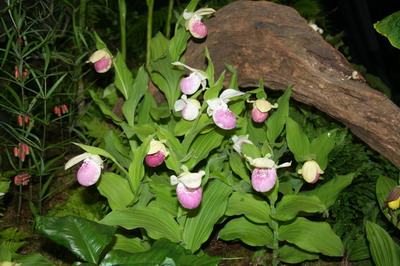
Cypripedium reginae
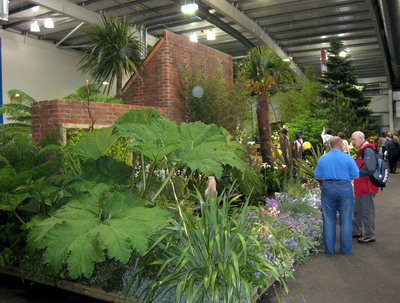
Back inside at the Botanics I was able to get close to the central feature, a tiered series of fish tanks.

Fish tank at centre of RBGE exhibit
I liked the way that the stand had been designed so that all the family could be fascinated. The metal dragonflies hovered just above the water, surrounded by orchids.
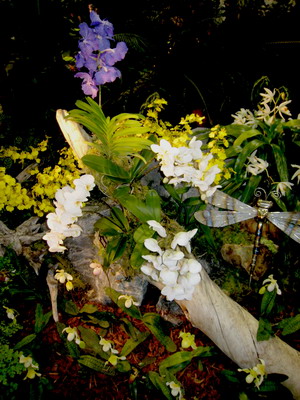
Metal dragonfly
Shrubs I admired
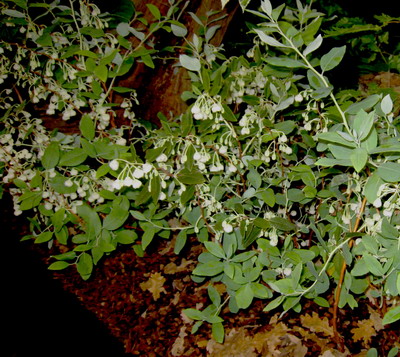
Zenobia pulverulenta 'Blue Skies'
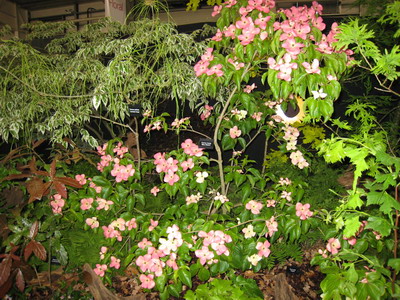
Cornus kousa MissSatomi.
I haven't grown Streptocarpus but if I did I would ask at Dibley's. They had some wonderfully floriferous plants on their display, including some which were new.
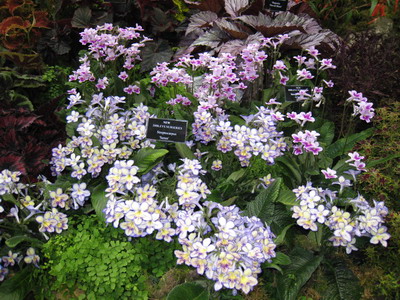 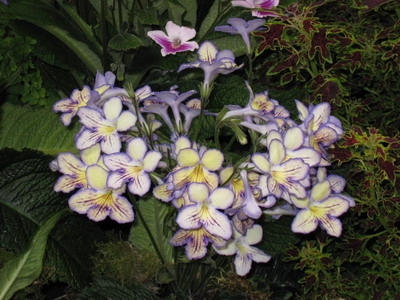
Streptocarpus 'Seren', a new variety. Creamy yellow throat, purple lines on a blue edged white flower.
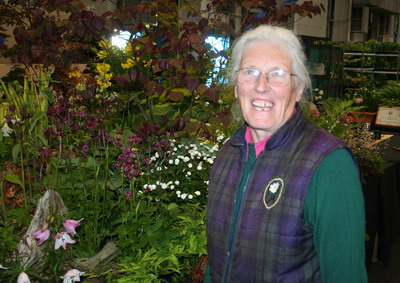 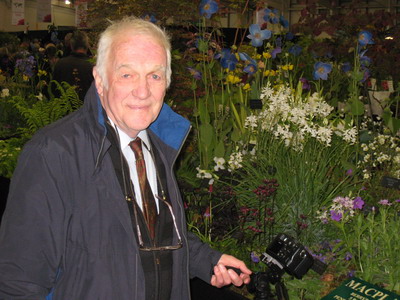
Mac Plants combined rock garden plants, troughs and herbaceous plants. There was something there for everyone of fine taste in matters horticultural. Beryl and Ian MacNaughton enjoyed the show in different ways. Beryl worked hard on the stand with Gavin and Ian took lots of fine pictures. Ian's Gentians are well known to SRGC members. The following are a tiny sample of their plants.
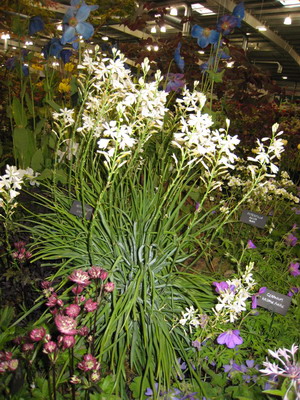
Anthericum liliago is not often seen in gardens but here was a fine stand'.
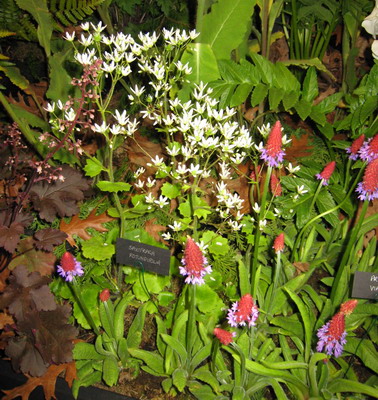
Primula vialii and Saxifraga rotundifolia
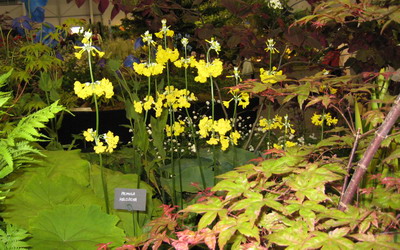
Primula helodoxa which looks great beside Meconosis
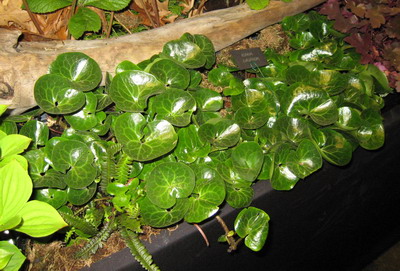
Asarum europeum wanders about slowly under bushes in the garden
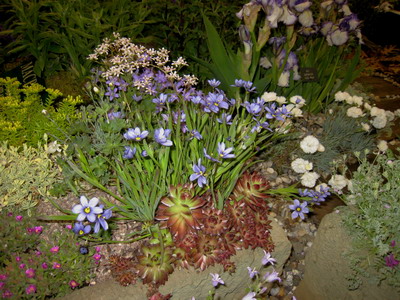
Sisyrinchium bermudianum
I thought I had found something quite special on Beryl's sales table. I thought this was a Helianthemum with tiny variegated foliage or a thyme with big flowers but it was a Helianthemum lying on top of a thymus!
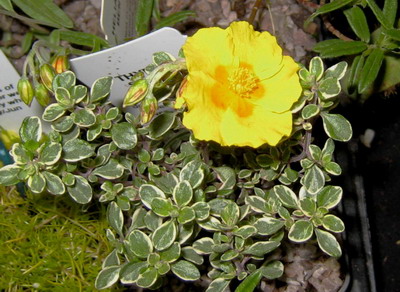
The Hosta and Hemerocallis Society showed here for the first time and they were good neighbours for the SRGC. A whole range of cultivars and when you asked the members were happy to talk about the plants. They had a good range of anti-slug defences.
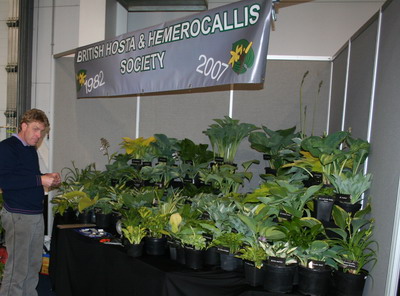 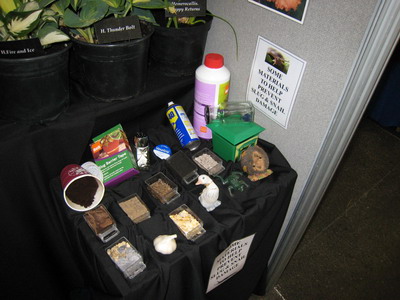
There is always a wide range of different plants to take your interest.
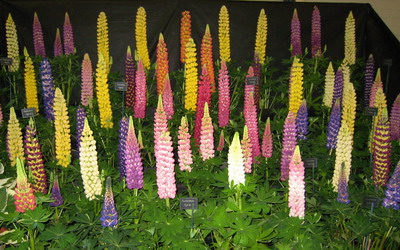
Lupins from Rose Dodds
Lots of SRGC members attend the show, so it takes a long time to wander round. Conversation and plants together keep a busy brain active. It was nice to see Margaret and Gareth Williams. Mgt seems to be blowing a kiss and maybe she was.
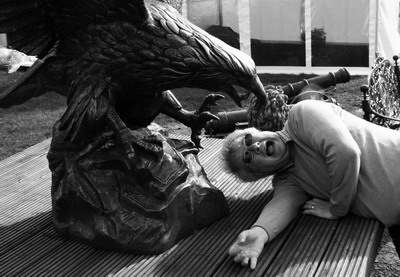
Finally! It can be dangerous work this reporting You never know when a big bird is going to bite your neck. Still, they say that in Glasgow as well!
^ back to the top ^
|

